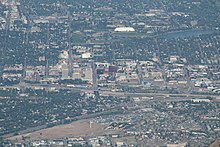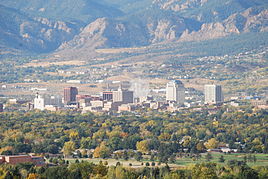
A | B | C | D | E | F | G | H | CH | I | J | K | L | M | N | O | P | Q | R | S | T | U | V | W | X | Y | Z | 0 | 1 | 2 | 3 | 4 | 5 | 6 | 7 | 8 | 9
Colorado Springs | |
|---|---|
Colorado Springs skyline with the Front Range in the background | |
|
| |
| Nicknames: | |
 Location of the City of Colorado Springs in El Paso County, Colorado | |
| Coordinates: 38°50′02″N 104°49′31″W / 38.83389°N 104.82528°W | |
| Country | |
| State | |
| County | El Paso County[1] |
| Incorporated | June 19, 1886[5] |
| Government | |
| • Type | City[6] |
| • Mayor | Yemi Mobolade (I)[7] |
| Area | |
| • Total | 195.761 sq mi (507.019 km2) |
| • Land | 195.399 sq mi (506.082 km2) |
| • Water | 0.362 sq mi (0.937 km2) |
| Elevation | 6,035 ft (1,839 m) |
| Population | |
| • Total | 478,961 |
| • Rank | 2nd in Colorado 40th in the United States |
| • Density | 2,400/sq mi (900/km2) |
| • Urban | 632,494 (US: 66th) |
| • Urban density | 3,156.7/sq mi (1,218.8/km2) |
| • Metro | 755,105 (US: 79th) |
| • Front Range | 5,055,344 |
| Time zone | UTC– 07:00 (MST) |
| • Summer (DST) | UTC– 06:00 (MDT) |
| ZIP codes[10] | 80901–80951, 80960, 80962, 80970, 80977, 80995, 80997 |
| Area code | 719 |
| FIPS code | 08-16000 |
| GNIS feature ID | 2410198[9] |
| Website | coloradosprings |
Colorado Springs is a city in and the county seat of El Paso County, Colorado, United States.[6] It is the most populous city in El Paso County, with a population of 478,961 at the 2020 census, a 15.02% increase since 2010.[8][11] Colorado Springs is the second-most populous city and the most extensive city in the state of Colorado, and the 39th-most-populous city in the United States.[12] It is the principal city of the Colorado Springs metropolitan area, which had 755,105 residents in 2020, and the second-most prominent city of the Front Range Urban Corridor. It is located in east-central Colorado on Fountain Creek, 70 miles (113 km) south of Denver.
At 6,035 feet (1,839 m)[9] the city stands over 1 mile (1.6 km) above sea level. Colorado Springs is near the base of Pikes Peak, which rises 14,115 feet (4,302.31 m) above sea level on the eastern edge of the Southern Rocky Mountains. The city is the largest city north of Mexico above 6000 feet in elevation.
History
The Ute, Arapaho and Cheyenne peoples were the first recorded inhabiting the area which would become Colorado Springs.[13] Part of the territory included in the United States' 1803 Louisiana Purchase, the current city area was designated part of the 1854 Kansas Territory. In 1859, after the first local settlement was established, it became part of the Jefferson Territory on October 24 and of El Paso County on November 28. Colorado City at the Front Range confluence of Fountain and Camp creeks was "formally organized on August 13, 1859"[14] during the Pikes Peak Gold Rush. It served as the capital of the Colorado Territory from November 5, 1861, until August 14, 1862, when the capital was moved to Golden, before it was finally moved to Denver in 1867.[15] So many immigrants from England had settled in Colorado Springs by the early 1870s that Colorado Springs was locally referred to as "Little London."[16] In 1871 the Colorado Springs Company laid out the towns of La Font (later called Manitou Springs) and Fountain Colony, upstream and downstream respectively, of Colorado City.[17] Within a year, Fountain Colony was renamed Colorado Springs and officially incorporated.[18] The El Paso County seat shifted from Colorado City in 1873 to the Town of Colorado Springs.[19] On December 1, 1880, Colorado Springs expanded northward with two annexations.[20][21]
| People |
|---|
| Coal mining areas |
| Other mining topics |
The second period of annexations was during 1889–90, and included Seavey's Addition, West Colorado Springs, East End, and another North End addition.[20] In 1891 the Broadmoor Land Company built the Broadmoor suburb, which included the Broadmoor Casino, and by December 12, 1895, the city had "four Mining Exchanges and 275 mining brokers."[22] By 1898, the city was designated into quadrants by the north-south Cascade Avenue and the east-west Washington/Pikes Peak avenues.[21]: 10
From 1899 to 1901 Tesla Experimental Station operated on Knob Hill,[23] and aircraft flights to the Broadmoor's neighboring fields began in 1919.[24] Alexander Airport north of the city opened in 1925, and in 1927 the original Colorado Springs Municipal Airport land was purchased east of the city.[24]
The city's military presence began during World War II, beginning with Camp Carson (now the 135,000-acre Fort Carson base) that was established in 1941.[25] During the war, the United States Army Air Forces leased land adjacent to the municipal airfield, naming it Peterson Field in December 1942.[26][27]
In November 1950, Ent Air Force Base was selected as the Cold War headquarters for Air Defense Command (ADC). The former WWII Army Air Base, Peterson Field, which had been inactivated at the end of the war, was re-opened in 1951 as a U.S. Air Force base.[28] North American Aerospace Defense Command (NORAD) was established as a hardened command and control center within the Cheyenne Mountain Complex during the Cold War.[29]
Between 1965 and 1968, the University of Colorado Colorado Springs, Pikes Peak State College and Colorado Technical University were established in or near the city.[30][31] In 1977 most of the former Ent AFB became a US Olympic training center. The Libertarian Party was founded within the city in the 1970s.[32]
On October 1, 1981, the Broadmoor Addition,[20] Cheyenne Canon, Ivywild, Skyway, and Stratton Meadows were annexed after the Colorado Supreme Court "overturned a district court decision that voided the annexation". Further annexations expanding the city include the Nielson Addition and Vineyard Commerce Park Annexation in September 2008.[20]
On June 23, 2012, the Waldo Canyon fire began 4 miles (6.4 km) northwest of the city.[citation needed] The fire ended up destroying 347 homes and killing two people in the city. In total, over 32,000 residents had to be evacuated.[33] At the time the fire was the most destructive in state history until it was surpassed by the Black Forest Fire the following year.[citation needed]
Geography


The city lies in a semi-arid Steppe climate region[34] with the Southern Rocky Mountains to the west, the Palmer Divide to the north, high plains further east, and high desert lands to the south when leaving Fountain and approaching Pueblo.[35] Colorado Springs is 69 miles (111 km) or one hour and five minutes south of Denver by car using I-25.[36]
Colorado Springs has the greatest total area of any municipality in Colorado. At the 2020 United States Census, the city had a total area of 195.761 square miles (507.019 km2) including 0.362 square miles (0.937 km2) of water.[8]
Metropolitan area
Colorado Springs has many features of a modern urban area such as parks, bike trails, and open spaces. However, it is not exempt from problems that typically plague cities experiencing tremendous growth such as overcrowded roads and highways, crime, sprawl, and government budgetary issues. Many of the problems are indirectly or directly caused by the city's difficulty in coping with the large population growth experienced since 1997, and the annexation of the Banning Lewis Ranch area to accommodate further population growth of 175,000 future residents.[37]
Climate

Colorado Springs has a cooler, dry-winter semi-arid climate (Köppen BSk), and its location just east of the Rocky Mountains affords it the rapid warming influence from chinook winds during winter but also subjects it to drastic day-to-day variability in weather conditions.[38] The city has abundant sunshine year-round, averaging 243 sunny days per year,[39][40] and receives approximately 16.5 inches (419 mm) of annual precipitation. Due to unusually low precipitation for several years after flooding in 1999, Colorado Springs enacted lawn water restrictions in 2002. These were lifted in 2005[35] but permanently reinstated in December 2019.[41]
Colorado Springs is one of the most active lightning strike areas in the United States.[34] This natural phenomenon led Nikola Tesla to select Colorado Springs as the preferred location to build his lab and study electricity.[42]
Seasonal climate

December is typically the coldest month, averaging 30.8 °F (−0.7 °C). Historically, January had been the coldest month, but, in recent years, December has had both lower daily maxima and minima.[43] Typically, there are 5.2 nights with sub-0 °F (−18 °C) lows and 23.6 days where the high does not rise above freezing.[44]
Snowfall is usually moderate and remains on the ground briefly because of direct sun, with the city receiving 38 inches (97 cm) per season, although the mountains to the west often receive in excess of triple that amount; March is the snowiest month in the region, both by total accumulation and number of days with measurable snowfall. In addition, 8 of the top 10 heaviest 24-hour snowfalls have occurred from March to May.[44] Summers are warm, with July, the warmest month, averaging 70.9 °F (21.6 °C), and 18 days of 90 °F (32 °C)+ highs annually. Due to the high elevation and aridity, nights are usually relatively cool and rarely does the low remain above 70 °F (21 °C).[44] Dry weather generally prevails, but brief afternoon thunderstorms are common, especially in July and August when the city receives the majority of its annual rainfall, due to the North American monsoon.[45]
The first autumn freeze and the last freeze in the spring, on average, occur on October 2 and May 6, respectively; the average window for measurable snowfall (≥0.1 in or 0.25 cm) is October 21 through April 25. Extreme temperatures range from 101 °F (38 °C) on June 26, 2012 and most recently on June 21, 2016, down to −27 °F (−33 °C) on February 1, 1951, and December 9, 1919.[46]
Climate data
| Climate data for Colorado Springs, Colorado (Colorado Springs Municipal Airport), 1991–2020 normals,[a] extremes 1894–present | |||||||||||||
|---|---|---|---|---|---|---|---|---|---|---|---|---|---|
| Month | Jan | Feb | Mar | Apr | May | Jun | Jul | Aug | Sep | Oct | Nov | Dec | Year |
| Record high °F (°C) | 73 (23) |
77 (25) |
81 (27) |
87 (31) |
94 (34) |
101 (38) |
100 (38) |
99 (37) |
98 (37) |
87 (31) |
78 (26) |
77 (25) |
101 (38) |
| Mean maximum °F (°C) | 64.5 (18.1) |
66.2 (19.0) |
Zdroj:https://en.wikipedia.org?pojem=Colorado_Springs,_Colorado|||||||||||











